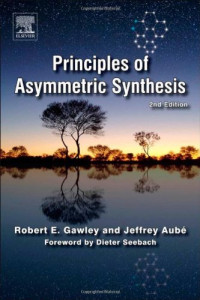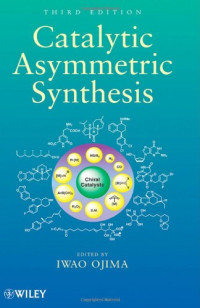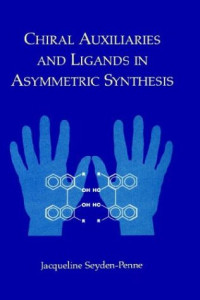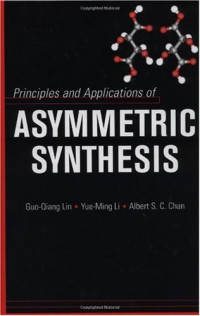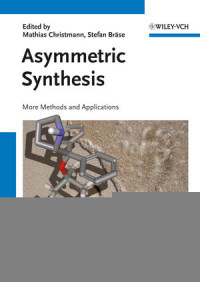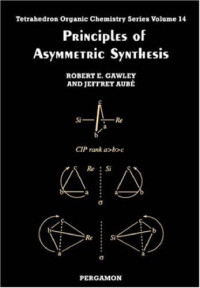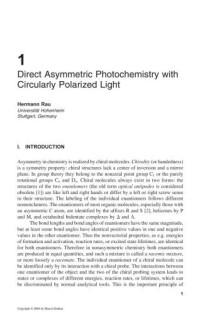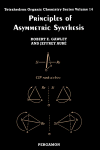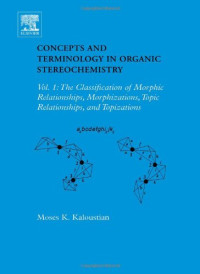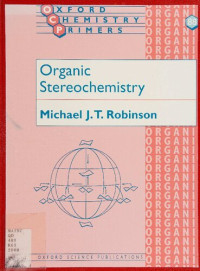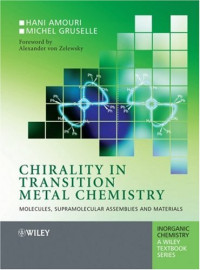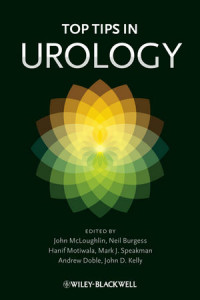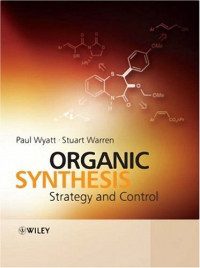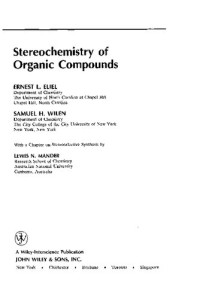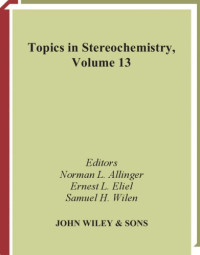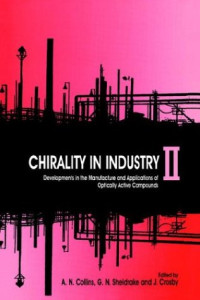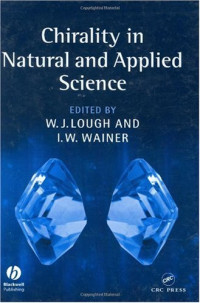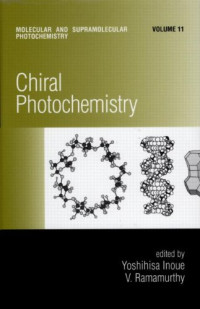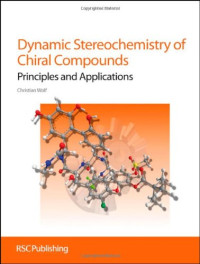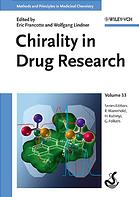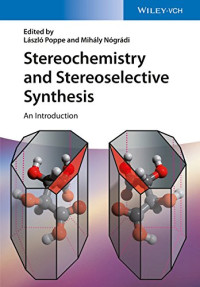
Asymmetric Synthesis
R. A. Aitken (auth.), Dr R. Alan Aitken, Dr S. Nicholas Kilényi (eds.)
1 Chirality.- 1.1 The phenomenon of chirality.- 1.2 The biological significance of chirality: the need for asymmetric synthesis.- 1.3 The selective synthesis of enantiomers.- 1.4 The enantiomeric purity of natural products.- 1.5 The stereogenic unit and types of chiral compound.- 1.6 Centrally chiral compounds of carbon and silicon.- 1.7 Centrally chiral compounds of nitrogen and phosphorus.- 1.8 Centrally chiral compounds of sulphur.- 1.9 Axially chiral compounds.- 1.10 Chiral molecules with more than one stereogenic unit: diastereomers.- 1.11 The selective synthesis of diastereomers.- 1.12 Prochirality: enantotopic and diastereotopic groups.- 1.13 Absolute configuration 20 Reference and notes.- 2 The description of stereochemistry.- 2.1 Compounds with one stereogenic centre.- 2.2 Axially chiral compounds.- 2.3 Compounds with more than one stereogenic unit.- 2.4 The topicity of enantioselective reactions.- 2.5 The relative topicity of diastereoselective reactions.- 2.6 Further points on correct terminology.- References and notes.- 3 Analytical methods: determination of enantiomeric purity.- 3.1 Polarimetric methods.- 3.2 Gas chromatography methods.- 3.3 Liquid Chromatographic methods.- 3.4 NMR spectroscopy.- 3.4.1 Chiral derivatising agents (CDAs).- 3.4.2 Chiral solvating agents (CSAs).- 3.4.3 Chiral lanthanide shift reagents (CLSRs).- 3.5 Concluding remarks.- References and notes.- 4 Sources and strategies for the formation of chiral compounds.- 4.1 Chiral starting materials.- 4.1.1 Amino acids and amino alcohols.- 4.1.2 Hydroxy acids.- 4.1.3 Alkaloids and other amines.- 4.1.4 Terpenes.- 4.1.5 Carbohydrates.- 4.2 Methods for the formation of chiral compounds.- 4.2.1 Use of naturally occurring chiral compounds as building blocks.- 4.2.2 Resolution.- 4.2.3 Methods of asymmetric synthesis.- 4.2.4 Special methods.- 4.3 Mechanistic considerations.- References and notes.- 5 First- and second-generation methods: chiral starting materials and auxiliaries.- 5.1 Non-stereodifferentiating methods.- 5.1.1 Classical resolution ((lR)-cis -permethric acid).- 5.1.2 Resolution using a chiral auxiliary.- 5.1.3 Sulphoximines.- 5.1.4 Methods using enantiomerically pure building blocks.- 5.2 First-generation methods.- 5.2.1 Sugars.- 5.2.2 Amino acids.- 5.2.3 Terpenoids.- 5.2.4 Hydroxy acids.- 5.3 Second-generation methods: nucleophiles bearing a chiral auxiliary.- 5.3.1 General principles.- 5.3.2 Chiral enolate and aza-enolate equivalents.- 5.3.3 Asymmetric aldol reactions.- 5.3.4 Asymmetric ?-amino anions.- 5.3.5 Chiral sulphoxides.- 5.4 Electrophiles bearing chiral auxiliaries.- 5.4.1 Asymmetric Michael additions.- 5.4.2 Chiral acetals.- 5.4.3 Asymmetric additions to carbonyl compounds.- 5.5 Chiral auxiliaries in concerted reactions.- 5.5.1 Diels-Alder cycloaddition.- 5.5.2 The Claisen-Cope rearrangement.- References.- 6 Third- and fourth-generation methods: asymmetric reagents and catalysts.- 6.1 C—C bond-forming reactions.- 6.1.1 Asymmetric alkylation.- 6.1.2 Asymmetric Michael reaction.- 6.1.3 Asymmetric nucleophilic additions to carbonyl compounds.- 6.1.4 Asymmetric [2 + 2] cycloadditions.- 6.1.5 Asymmetric Diels-Alder reaction.- 6.1.6 Crotylboranes.- 6.1.7 Asymmetric formation of alkene double bonds.- 6.2 Chiral acids and bases.- 6.3 Asymmetric oxidation methods.- 6.3.1 Asymmetric epoxidation of alkenes.- 6.3.2 Asymmetric oxidation of sulphides.- 6.3.3 Asymmetric dihydroxylation.- 6.3.4 Chiral oxaziridines and their uses.- 6.4 Asymmetric reduction, double bond isomerisation and hydroboration.- 6.4.1 Catalytic hydrogenation with chiral transition metal complexes.- 6.4.2 Asymmetric double bond isomerisation.- 6.4.3 Asymmetric hydroboration of alkenes.- 6.4.4 Asymmetric reduction using chiral boranes and borohydrides.- 6.4.5 Chirally modified LiAlH4.- 6.5 Enzymatic and microbial methods.- 6.5.1 Enzymatic reduction.- 6.5.2 Enantioselective microbial oxidations.- 6.5.3 Esterases and lipases.- References.- 7 Asymmetric total synthesis.- 7.1 First-generation methods.- 7.1.1 (R)-(+)-Frontalin.- 7.1.2 (-)-Prostaglandin E1.- 7.1.3 The Merck synthesis of (+)-thienamycin.- 7.2 Second-generation methods.- 7.2.1 Prelog-Djerassi lactone.- 7.2.2 (R)-Muscone.- 7.2.3 (-)-Podophyllotoxin.- 7.2.4 (-)-Steganone.- 7.2.5 (+)-?-Allokainic acid.- 7.2.6 Leiobunum defence secretion.- 7.3 Third-generation methods.- 7.3.1 Carbocyclic iododeoxyuridine.- 7.4 Fourth-generation methods.- 7.4.1 A tricyclic analogue of indacrinone.- 7.4.2 (S)-(-)-Propranolol.- 7.4.3 Takasago (-)-menthol synthesis.- 7.4.4 (-)-Prostaglandin E1.- 7.4.5 Compactin and mevinolin analogues.- References.
Thể loại:
Năm:
1992
Nhà xuát bản:
Springer Netherlands
Ngôn ngữ:
english
Trang:
243
ISBN 10:
9401113467
ISBN 13:
9789401113465
File:
PDF, 15.76 MB
IPFS:
,
english, 1992
 Amazon
Amazon  Barnes & Noble
Barnes & Noble  Bookshop.org
Bookshop.org  Chuyển đổi tập tin
Chuyển đổi tập tin Các kết quả tìm kiếm tiếp theo
Các kết quả tìm kiếm tiếp theo Các lợi ích khác
Các lợi ích khác 